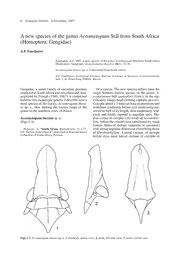
A new species of the genus Acrometopum Stål from South Africa (Homoptera: Gengidae) PDF
Preview A new species of the genus Acrometopum Stål from South Africa (Homoptera: Gengidae)
© Zoological Institute, St.Petersburg, 2007 A new species of the genus Acrometopum Stål from South Africa (Homoptera: Gengidae) A.F. Emeljanov Emeljanov, A.F. 2007. A new species of the genus Acrometopum Stål from South Africa (Homoptera: Gengidae). Zoosystematica Rossica, 16(1): 25-26. Acrometopum theroni sp. n. is described from South Africa. A.F. Emeljanov, Zoological Institute, Russian Academy of Sciences, Universitetskaya nab. 1, St. Petersburg 199034, Russia. Gengidae, a small family of uncertain position Description. The new species differs from the restricted to South Africa was described and char- single hitherto known species of the genus, A. acterized by Fennah (1949, 1967); it comprised costatipenne Stål (panoplites Fenn.), in the sig- hitherto two monotypic genera. I describe here a nificantly longer head forming cephalic process. third species of the family, Acrometopum thero- Coryphe about 1.5 times as long as pronotum and ni sp. n., thus shifting the known range of the scutellum combined, before eyes moderately nar- genus to the southern coast of Africa. rowed to half of its length, then moderately wid- ened, and finally tapered to angulate apex. Me- Acrometopum theroni sp. n. dian carina of coryphe very weak up to constric- (Figs 1-3) tion, before the constriction substituted by weak furrow. Sides of metope (opposite to antennae) Holotype. F, “South Africa, Stellenbosch, 15-4-77, with strong angulate dilatations resembling those J.G. Theron, Jonkershoeck”, deposited at National Insect of Eurybrachyidae. Lateral carinae of metope Collection of South Africa, Pretoria. before eyes meet lateral carinae of coryphe at 2 3 1 Figs 1-3. Acrometopum theroni sp. n. 1, forebody, dorsal view; 2, head, left side view; 3, head, ventral view. 26 A.F. Emeljanov: A new species of Acrometopum • ZOOSYST. ROSSICA Vol. 16 acute angle at a distance equal to eye length; a verse veins. The elytra of the new species are very little in front of this confluence, metope with similar to those of the examined paratypes of short carina parallel to metopal one and reaching Gengis panoplites Fenn., including the dilatations its lateral margin in site of constriction. Cross mentioned. Legs relatively short, rather thin; hind section of metope just before eyes very convex; tibiae with 5 lateral spines, first of them in basal median carina absent; before apex from below, third of tibia; genicular (basal) spine absent. metope bears a laterally compressed knob, from Metabasitarsus with 5 strong denticles. which a median carina runs up to apex of head; Teguments reddish brown; legs and underside probably, this is apical carina (intermedial cari- of body light brown. Metope with blackened sub- nae of metope near the knob not present). Inter- apical knob and recognizable brown spot in its mediate carinae of metope appreciable nearly middle part. Hind femora and base of tibiae dark- from level of eyes to level of coryphe constric- er. Abdomen beneath dark brown. tion; they are directed towards the knob, but do Length F 8.4 mm. not reach it. Pronotum and scutellum as in A. Comparison. The new species is readily dis- costatipenne. Elytra together oblong oval, con- tinguished from A. costatipenne Stål in the long vex, reaching apex of abdomen; each elytron head and presence of carinae or their vestiges on shortly rounded at apex. Veins of elytra carini- metope (they are absent in A. costatipenne Stål). form; costal vein with sharp (subfoliate) lateral carina; ScR forked in middle part of elytra; M Acknowledgements and Cu fused basally up to level of bifurcation of ScR; free M not branching; CuA forked at lev- I am very grateful to Dr M. Stiller (National Insect el of claval apex or a little before it; CuP mark- Collection, Pretoria) for the opportunity to describe this interesting material. ing the line of claval suture distinct but weak, so that suture lacking; claval veins strong; common References vein (Pcu+A ) running parallel to sutural margin 1 up to vestige of claval suture. Vein RP at level of Fennah, R.G. 1949. A new genus of Fulgoroidea (Homop- claval apex forming lobiform dilatation; vein tera) from South Africa. Ann. Mag. Natur. Hist., CuA1 forming a similar but more raised dilata- 12(2): 111-120. tion in middle part of membrane; both dilatations Fennah, R.G. 1967. New and little known Fulgoroidea blackened. Hind (terminal) margin of membrane from South Africa (Homoptera). Ann. Natal Mus., with irregular submarginal row of weak trans- 18(3): 655-714. Received 15 April 2007
